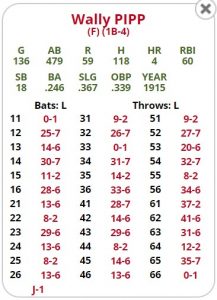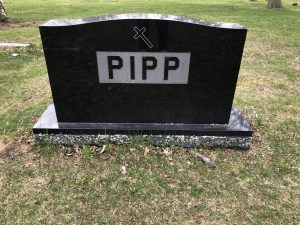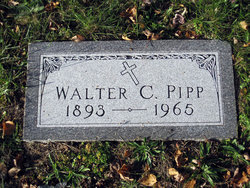
An interesting rabbit hole to jump into is researching the Major League players that are connected to your home town. APBA cards have a great habit of leading us in such directions because it is so easy to glance at the birthdates, home towns, and nicknames on our APBA cards.
There’s a long list of players who played in the Big Leagues who have some sort of connection to West Michigan. More specifically, there are more than a dozen players who made it to The Show who hail from my current hometown of Grand Rapids. One of those is Wally Pipp, known most for having a headache that helped start Lou Gehrig’s famous iron man consecutive games streak.

Though Walter Pipp was born in Chicago in 1893, he grew up in Grand Rapids, Michigan. He died in 1965 and is buried at Woodlawn Cemetery, which is about a twenty-minute drive from my house. After a crazy white swan caused a two-hour power outage in my neighborhood, I asked my wife and daughter (and chocolate labrador retriever) if they’d like to take a ride to see the grave of an old ballplayer who played with Babe Ruth and Lou Gehrig. Surprisingly, they didn’t resist a bit…it’s crazy what self-quarantine will do to you. After a little searching, we found Wally Pipp’s grave.

Pipp started his professional career in 1912 by playing for the Class D Southern Michigan League’s Kalamazoo Celery Champs. The 19-year old’s athleticism, size (6-2 195 pounds), and potential caught the eye of the Detroit Tigers, who bought his contract. After spending most of 1913 in the minors, Wally was called up to the Tigers for twelve games. He wasn’t impressive, only hitting .161 in thirty-one at-bats. Once again in 1914, he’d spend the season in the minors before being sold to the New York Yankees.
Like everything in baseball history, APBA cards need to be considered with perspective and in context. This first Wally Pipp card is a dead ball era card that represents the beginnings of one of that era’s best sluggers. Upon first glance, four home runs aren’t very impressive. However, remember the American League leader in home runs in 1915 was Braggo Roth…with SEVEN. Though this card is designed to hit .246, I project it to produce a .275 average. For some reason, APBA gave Pipp an extra 8, which is the difference. With the standard three 8s, this card would produce a .250 average. Maybe APBA was taking into account the superior, overall pitching of the dead-ball era. Impressively, Pipp hit 13 triples in 1915. If you look at the second column, you’ll notice ten 2s. Not only was Pipp one of the best fielding first basemen of his era, he was also fast. Hitting 10+ triples eight times, leading the league with 19 in 1924, and stealing 10+ bases in six seasons.
In dead-ball times, triples were the mark of a power hitter. Wally Pipp was a power hitter and even had the strikeouts to prove it. He led the league in whiffs in 1916…with 82. Even the great Tris Speaker, known for playing shallow, used to back up when Pipp was in the box. However, Wally Pipp was the New York Yankees’ first great home run hitter and he was the first Yankee to lead the league in homers when he socked 12 in 1916. He retained his home run crown in 1917 when he led the league again with 9 homers. If Pipp was healthy and in the lineup, he’d usually hit close to double-digit homers with around a .300 average and close to 100 RBI. At the end of the dead-ball era, those were great numbers for a slick-fielding first baseman.
The story is not definitive on how Wally Pipp gave up his spot in the lineup to Lou Gehrig in 1925. The only certainty is that he didn’t play and Gehrig did. Pipp did have a headache, which was a recurring problem throughout his life. When he was growing up, he was hit in the left eye with a puck during a hockey game. Whatever the case, he did ask the trainer for some aspirin on June 2, 1925, and Miller Huggins did replace him in the lineup. Whether or not Pipp took himself out of the lineup will never be known. Unfortunately, the legend says he did it himself, and now we have the term “Wally Pipp-ed” in our sports lexicon. As for Pipp, he is best known as the man who got replaced by Lou Gehrig, not as one of the great sluggers of the late dead-ball era. History can be cruel.




Great article, but it would have been nice to use a regular APBA card that includes the bio information.
I somehow missed this. Great piece, Kevin!
Pipp was always known as the one Gehrig replaced. He was pretty good in own right.
Tom